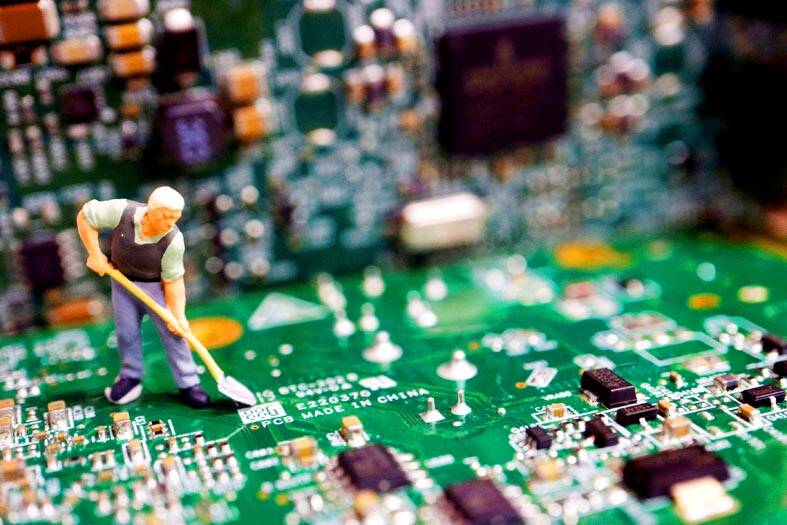The US semiconductor industry faces a shortfall of about 67,000 workers by 2030, an industry association study published yesterday said.
The chip industry’s workforce is projected to grow to 460,000 by the end of the decade, up from about 345,000 this year.
However, at the rate that people are graduating from schools, the US cannot not produce enough qualified workers to fill the increase, said the study prepared by the Semiconductor Industry Association (SIA) and Oxford Economics.

Photo: Reuters
The study comes as the US works to improve its domestic chip sector. The US’ Creating Helpful Incentives to Produce Semiconductors (CHIPS) and Science Act, which sets aside money for new manufacturing sites, and research and development, was signed into law on Aug. 9 last year.
The US Department of Commerce is overseeing the US$39 billion in manufacturing subsidies stipulated under the act, and companies such as Intel Corp, Taiwan Semiconductor Manufacturing Co (台積電) and Samsung Electronics Co have said they would apply for them.
The law also created a 25 percent investment tax credit for building new chip factories, or fabs, that is worth US$24 billion.
Those factories would create jobs, the SIA said.
The projected shortage includes computer scientists, engineers and technicians. Roughly half of future chip industry jobs are expected to be for engineers.
“This has been a problem that we’ve been facing for a long time,” SIA president John Neuffer said. “But with the CHIPS Act in particular, and the kind of the bending the arc of history towards more manufacture here on US shores, it really kind of threw this acute problem into bold relief.”
The shortage of skilled chip workers is part of a larger shortfall of science, technology, engineering and math graduates in the US, the report said, adding that by the end of this year, 1.4 million positions might go unfulfilled.

Application-specific integrated circuit designer Faraday Technology Corp (智原) yesterday said that although revenue this quarter would decline 30 percent from last quarter, it retained its full-year forecast of revenue growth of 100 percent. The company attributed the quarterly drop to a slowdown in customers’ production of chips using Faraday’s advanced packaging technology. The company is still confident about its revenue growth this year, given its strong “design-win” — or the projects it won to help customers design their chips, Faraday president Steve Wang (王國雍) told an online earnings conference. “The design-win this year is better than we expected. We believe we will win

Intel Corp chief executive officer Lip-Bu Tan (陳立武) is expected to meet with Taiwanese suppliers next month in conjunction with the opening of the Computex Taipei trade show, supply chain sources said on Monday. The visit, the first for Tan to Taiwan since assuming his new post last month, would be aimed at enhancing Intel’s ties with suppliers in Taiwan as he attempts to help turn around the struggling US chipmaker, the sources said. Tan is to hold a banquet to celebrate Intel’s 40-year presence in Taiwan before Computex opens on May 20 and invite dozens of Taiwanese suppliers to exchange views

Chizuko Kimura has become the first female sushi chef in the world to win a Michelin star, fulfilling a promise she made to her dying husband to continue his legacy. The 54-year-old Japanese chef regained the Michelin star her late husband, Shunei Kimura, won three years ago for their Sushi Shunei restaurant in Paris. For Shunei Kimura, the star was a dream come true. However, the joy was short-lived. He died from cancer just three months later in June 2022. He was 65. The following year, the restaurant in the heart of Montmartre lost its star rating. Chizuko Kimura insisted that the new star is still down

While China’s leaders use their economic and political might to fight US President Donald Trump’s trade war “to the end,” its army of social media soldiers are embarking on a more humorous campaign online. Trump’s tariff blitz has seen Washington and Beijing impose eye-watering duties on imports from the other, fanning a standoff between the economic superpowers that has sparked global recession fears and sent markets into a tailspin. Trump says his policy is a response to years of being “ripped off” by other countries and aims to bring manufacturing to the US, forcing companies to employ US workers. However, China’s online warriors